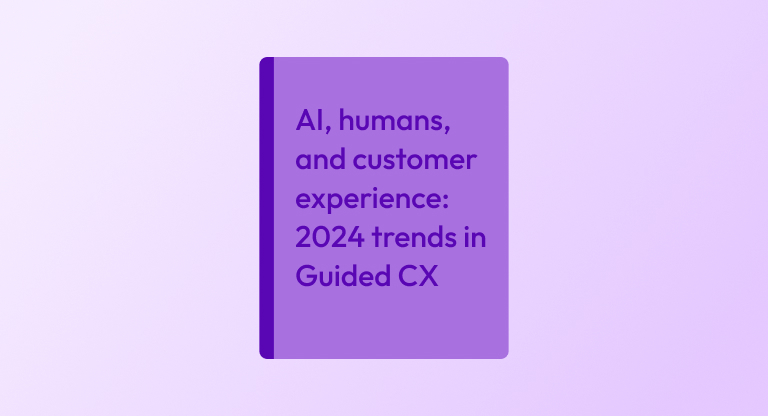
Originally published in No Jitter
By Tom Martin, CEO, Glance
September 14, 2020
Like all American businesses, financial companies have felt the impact of COVID-19. For decades, these institutions have competed to build lifelong customer relationships based on superior customer service, personal interactions, and the ability to match the right financial product or strategy to a customer’s specific needs.
Of course, the reliance on face-to-face interaction has been derailed due to the shutdown and WFH mandates. Many retailers, restaurants, and travel and hospitality enterprises have seen their brands and businesses devastated by this pandemic. But banks are having different experiences, meeting the challenge by accelerating their already rapid deployment of digital engagement tools.
Now’s the Time
These institutions are finding that their experiences using digital technologies are far more transformative than managing the effects of the pandemic. Many are leveraging these capabilities to expand their reach into new territories, offer new services, and alter a competitive landscape that has been resistant to change for years.
All organizations recognize this seismic shift and make sure they have the appropriate digital tools — and get comfortable using them — as quickly as possible. Customer use of digital and mobile apps for banking, lending, and investment activities are already skyrocketing. The clock is ticking, and those institutions that have not already developed a digital engagement strategy need to step on the gas — for the sake of their employees, customers, and all stakeholders.
Visual Engagement: A Primer
Engaging with and supporting customers using digital tools has become imperative to win and retain customers. Many banks have implemented self-service features utilizing AI and bots for managing some of the more rudimentary customer service tasks — such as providing account balances, resetting passwords, and answering frequently asked questions.
But self-service, AI, and bot-based support can only get you so far. The organizations that will win and retain customers are the ones who can build and maintain trust and fulfill the customer’s emotional needs during more complex digital interactions.
How do you provide the human touch while guiding a customer to execute an online transfer? How do you digitally consult with a customer looking at available loan options and then guide them through the lengthy digital application process all the way through e-signature? How do you deliver a secure and private investment consultation and then guide the consumer through the digital trading process? These are all scenarios that are complex, fraught with emotion, and require the human expertise of your enterprise’s financial knowledge workers — human expertise and empathy delivered via a digital channel.
Simply put, visual engagement technology enables knowledge workers to join customers in web or mobile applications. Adding the human element to digital interactions is proven to increase customer satisfaction, increase transaction conversion, grow trust, and build lifelong customer loyalty.
Adding the Human Element to Digital Interactions
Integrating visual engagement into digital touchpoints is a proven, straightforward process. Cloud-based visual engagement functionality can typically be integrated with existing websites, apps, and infrastructure. It can be integrated with CRM or contact center systems, document management services, voice communications networks, and core banking platforms. The cloud architecture streamlines the deployment process, giving enterprises the ability to add visual engagement into the customer journeys and digital touchpoints it feels are best suited for live support and expert consultation.
While visual engagement technology can undoubtedly be an essential asset in today’s environment, security-conscious institutions should also understand that not all solutions are created equal. A bank, insurance firm, healthcare provider, or other entity in a highly regulated environment should check that providers have the requisite certifications, protocols, and processes in place to confirm compliance with these mandates.
Another important aspect is interoperability and accessibility. Just because certain solutions are cloud-based does not guarantee that they will work uniformly across all browsers and devices. For example, banks should ensure that the visual engagement solution has the technical and bandwidth requirements to ensure satisfactory performance even in challenging and difficult to control environments.
The same dynamic holds true with devices. There may be solutions that work exceedingly well with a specific smartphone or tablet operating system, but the experience quickly changes with another product.
The key for successfully using visual engagement technology — for both customers and staff — is to deliver an experience that works equally well and with a consistent user interface across all types of browsers and devices. Customers are not going to forego their preferred device just to interact with a bank or any other business. Likewise, a consistent UI enables online knowledge workers to support the customer no matter what device or digital channels the customer might prefer. Organizations would be well-advised to ensure that whichever visual engagement solution it chooses works identically across all infrastructures and devices.
Why Use Visual Engagement?
For years, many institutions have recognized the efficiencies of digital environments and have taken steps to add these tools to their infrastructure. The onset of the pandemic instantly accelerated this process. Nobody anticipated the speed and severity of this transformation, and certainly, many customers were blindsided by the drastic change. In fact, the disruption left customers bewildered and frustrated — unable or unwilling to conduct business as they’ve been accustomed, instead being forced to navigate unfamiliar digital tools. Many have been unaccustomed to the bank’s websites, or unhappy about engaging with chatbots if they quickly needed information. On top of this, this anxiety only intensifies when customers want assistance for major financial transactions, such as shopping for a mortgage. In this customer service dynamic, existing AI tools are of little use. The technology is unable to convey empathy or humanity, and probably never will. Instead, banks found they had an urgent need to bring live representatives into digital conversations to satisfy customer expectations.
Find the Right Moment
The way in which visual engagement is introduced is essential for delivering positive customer experiences. It should be non-intrusive, but certainly valuable for the customer, and efficient for the online banker or representative.
Well-conceived visual engagement deployments are designed to complement the organization’s most critical customer journeys, giving institutions the ability to eliminate large and small points of friction that stop or delay transactions and cause customer frustration or abandonment. For banks, that moment could be helping customers navigate a labyrinth of credit products or mortgages. For other institutions, visual engagement can be useful in assisting customers complete applications and purchase additional products. Still, other businesses are using visual engagement more broadly, such as guiding customers to locate online resources. Visual engagement can be a strategic asset in almost any customer service environment, and that’s why enterprises are finding that it can deliver value equally well in frontline sales environments, as well as the customer service department.
Keeping the Human Connection in the Age of COVID-19
The effects of COVID-19 have given banks and other organizations the opportunity to re-evaluate how they interact with customers and identify new solutions and concepts that will improve the delivery of strategic guidance through digital channels. Visual engagement solutions have rightfully earned the trust of enterprises who recognize the need to maintain live human support, even as WFH requirements and social distancing make traditional brick-and-mortar customer service dynamics impossible. Even as AI continues to mature, businesses have found that nothing replaces human-to-human engagement. Visual engagement tools ensure that the human connection is — and will continue to be — the very cornerstone that customer service was built upon.
Click here to learn more about Glance for Financial Services.





